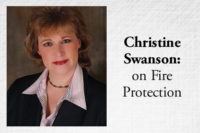Issue: 7/02
One of the keys to ensuring that a sprinkler system will be fully operational when needed is to provide supervision of the conditions that are essential for the proper operation of the sprinkler system. Along with periodic testing and maintenance according to applicable standards, knowing that all the valves that control the flow of water to any portion of the sprinkler system or water flow device is the best way to make sure everything will operate as expected. All of the control, test, and drain valves on a sprinkler system should have a permanent sign attached to them that describes their function and states whether they should be open or closed. These signs are required by NFPA13, 1999 3-8.3 and are available from most sprinkler distributors.
Most of the valves on sprinkler systems are used to either shut off the water supply to various sections for maintenance or to a water flow device. Since the main reason for sprinkler system failure is due to a closed valve, every valve that controls the flow of water to any portion of the sprinkler system should be open and have a valve supervisory switch installed on it.
Indicating Valves
Valves that are used for sprinkler systems are supposed to be indicating-type valves. This means a person should be able to tell whether the valve is open or shut by looking at it. There are mainly four types of these valves used:1. Post Indicator Valves (PIVs)--There are two types of these, usually found on the outside of the building. One is a yard-type, which looks a little like a fire hydrant and has at least one window in it that displays the words "OPEN" or "SHUT" on the target of the valve, depending on the valve condition. The yard PIV usually has a square operating nut on top and requires a special wrench, which is usually padlocked to the valve, to operate it. The other is a wall-type PIV, which extends from the outside of the building through the wall and attaches to the pipe on the inside of the building. It has the same windows and text as the yard-type, but this version has a large handwheel used to operate the valve. Both of these valves use the same type of tamper switch. There is usually a 1/2" pipe plug in the side, which can be removed and the switch screwed into the threaded hole. The tamper switch has a trip rod that is activated by the movement of the valve target.
2. Butterfly Valves--These use the same type of tamper switch as PIV valves; again, the switch is installed by removing a pipe plug and screwing the switch into the body of the valve. Butterfly valves operate by turning a crank or handwheel. There is a brightly colored flag or target to indicate valve position. When the valve is open, the flag is in line with the pipe. As the valve is closed, the flag moves so it is perpendicular to the pipe. Operating the valve also rotates a cam inside the valve, which operates the trip rod on the tamper switch.
3. OS&Y Valves--Another type of indicating valve is the Outside Screw & Yoke (OS&Y). It has a large handwheel for operation and a threaded rod (screw) going through the handwheel. There is a bracket (yoke) that runs on both sides of the screw. When the screw protrudes through the handwheel, the valve is open. When the screw is flush with the handwheel, the valve is closed. This valve requires a different type of tamper switch that mounts to the yoke and has a trip rod that operates out of a groove made in the screw. When the valve is fully open, the trip rod sits in the bottom of the groove. As the valve is closed, the screw moves into the valve body. This causes the trip rod to rise out of the groove and operate the tamper switch. As the valve is being completely closed, the trip rod will roll over the threaded portion of the valve screw, but this should not cause the tamper switch to trip and reset as it rolls over every thread.
4. Ball Valves--The last type is the ball valve, usually used on small pipes from 1/2" to 1". This valve has a handle that is the indicator. When the handle is in line with the pipe, the valve is open. Turning the handle a quarter of a turn closes the valve and places the handle perpendicular with the pipe. Valves are required to be installed in the alarm line to pressure-type water flow switches and/or water-motor-operated alarm devices per NFPA 13, 1999, 5-15.1.4. Sealing, locking, or removing the handle is not acceptable per NFPA 72, 1999, 3-8.3.3.3.2. Those valves as well as the valves on many small backflow preventers are usually ball valves.
Tamper Switches
For new installations where no valve exists, there is a company that manufactures a ball valve with a built-in tamper switch in sizes 1/2", 3/4", and 1". In certain situations, though, the combination ball valve/tamper switch cannot be used, such as backflow preventers, or existing trim on dry pipe valve or wet alarm check valves. For these types of applications where a ball valve is already installed, there is a tamper switch made that will install on existing ball valves. This Retrofit Ball Valve Switch meets the requirements of NFPA 13, 72, and 101. This device also allows for the supervision of 2" and smaller backflow preventers that typically have ball valves on them. Until this new retrofit ball valve switch came out, the only way to tamper them was with a plug-type switch. The valves cannot be replaced with a different valve that has not been submitted and approved for use with the backflow device.Occasionally, people will install "plug-type" tamper switches on some valves because they are in wet locations, such as outdoors or in pits subject to flooding. This is no longer necessary or recommended. There are now OS&Y and PIV tamper switches that are NEMA 6P rated. This means they can be submerged in water as long as watertight conduit is used. The only place a plug-type tamper switch should be used is on a non-rising stem-type valve. Plug-type switches are subject to the approval of the AHJ because the switch can be restored to normal without restoring the valve to normal. If you are installing or specifying a tamper switch for outdoor applications, make sure the device and conduit are both submersible. This will eliminate many problems, such as ground faults on the fire panel after a rain.
If you have any questions regarding the operation of a sprinkler system or how to supervise it, contact a distributor or a manufacturer of sprinkler monitoring equipment. They should be willing and able to provide the technical assistance necessary to make sure the job is done correctly. Education and training are the keys; get them and use them.

